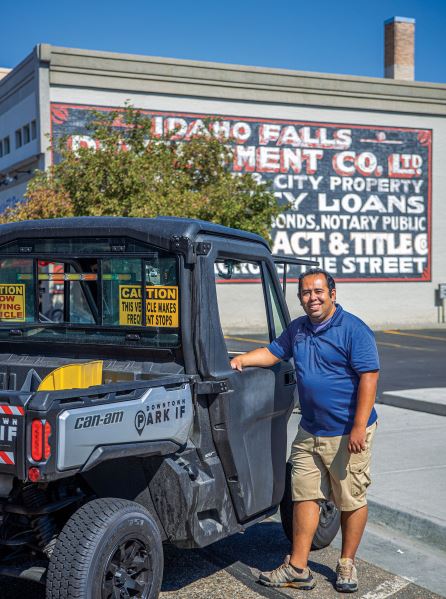
If you live, work or even visit downtown, you’ve probably had to grapple with the challenges of parking. Explore a bit further and you’ll discover that spaces throughout I.F.’s cultural district are actually quite plentiful, even if the coveted curbside spots are often taken.
Here at the B Street offices of Harris Publishing (parent company of Idaho Falls Magazine), we can relate. More than a few of our fellow employees have had numerous scrapes with the city’s old parking-enforcement regime. Up until about a year ago, the 2-hour time limit had become especially contentious, resulting in a never-ending game of musical cars and accumulations of ever-increasing fines.
Thankfully, a new-and-improved management and monitoring system is now in the capable hands of the Idaho Falls Downtown Development Corporation. We caught up with IFDDC parking ambassadors Juan Hernandez and Ed O’Reyah for details on how it is being received.
According to Juan, parking violations can negatively affect businesses that — especially in these trying times — need all the help they can get.
“When you’re parking beyond two hours, you’re hurting businesses that could use those spaces,” he said. “It’s great to have these businesses downtown, but when customers can’t find a space, it’s easier to say, ‘I’ll just go outside of downtown, or maybe up to the mall.’ That can hurt all the businesses on that block.”
Although parking rules can be a hassle, IFDDC’s program goes a long way in making time-restricted parking easier to understand for patrons and businesses alike, Ed told us.
“For starters, we have it all marked pretty clearly,” he said. “Every other block, we’ve got A-frames out there for you — all color-coordinated and easy to read.”
Online resources are also available at downtownidahofalls.com.
“If you look at the downtown website, we have a map that shows you where you can park for free, for two hours, and paid parking as well,” Juan added.
Just adjacent to downtown, more all-day free parking is available, courtesy of Union Pacific Railroad.
Ed and Juan agree that the job can be challenging, but most of the time, it comes down to educating the public.
“It’s just about letting them know what the rules are,” Ed said. “It’s been a challenge, but it has gotten a lot easier over the last 6 months or so. It’s actually been a lot of fun meeting people and working through the process, which has really been a positive one.”
Social-distance etiquette permitting, another tactic to further educate vehicle owners is to have them hop into IFDDC’s designated parking wagon (a UTV that is hard to miss) and give them a personalized tour and an explanation of how the system works.
“So when we get started in the morning, we scan the license plates with a GPS location and an image that shows the background of where the car is at,” Juan said. “Then when we come back 2 hours later, it will pop up an alert. At that point we’ll review to see if that car has been there the whole time.”
Although the limit is 2 hours, Ed and Juan actually offer an additional grace period of about 10 minutes.
As many downtown full-time employees can attest, the old chalk-the-tire system had its loopholes. For one, you could simply back up a couple feet or drive around the block and return to the same spot — all in an effort to conceal the chalk mark. That maneuver is less relevant with the new electronic system. Whether you roll the tires or do a loop back into the same spot, the results will be the same as if you didn’t move your car at all.
“We’ve been a small town for a long time, but it’s getting bigger,” Ed said. “That makes the education process all that more important.”
For more information about IFDDC’s online parking guide, downtown maps, pay-by-plate parking meters, citation payments and other cultural-district details, visit www.downtownidahofalls.com/parking or call 208-535-0399.
Click here to read more of the September issue of Idaho Falls Magazine.